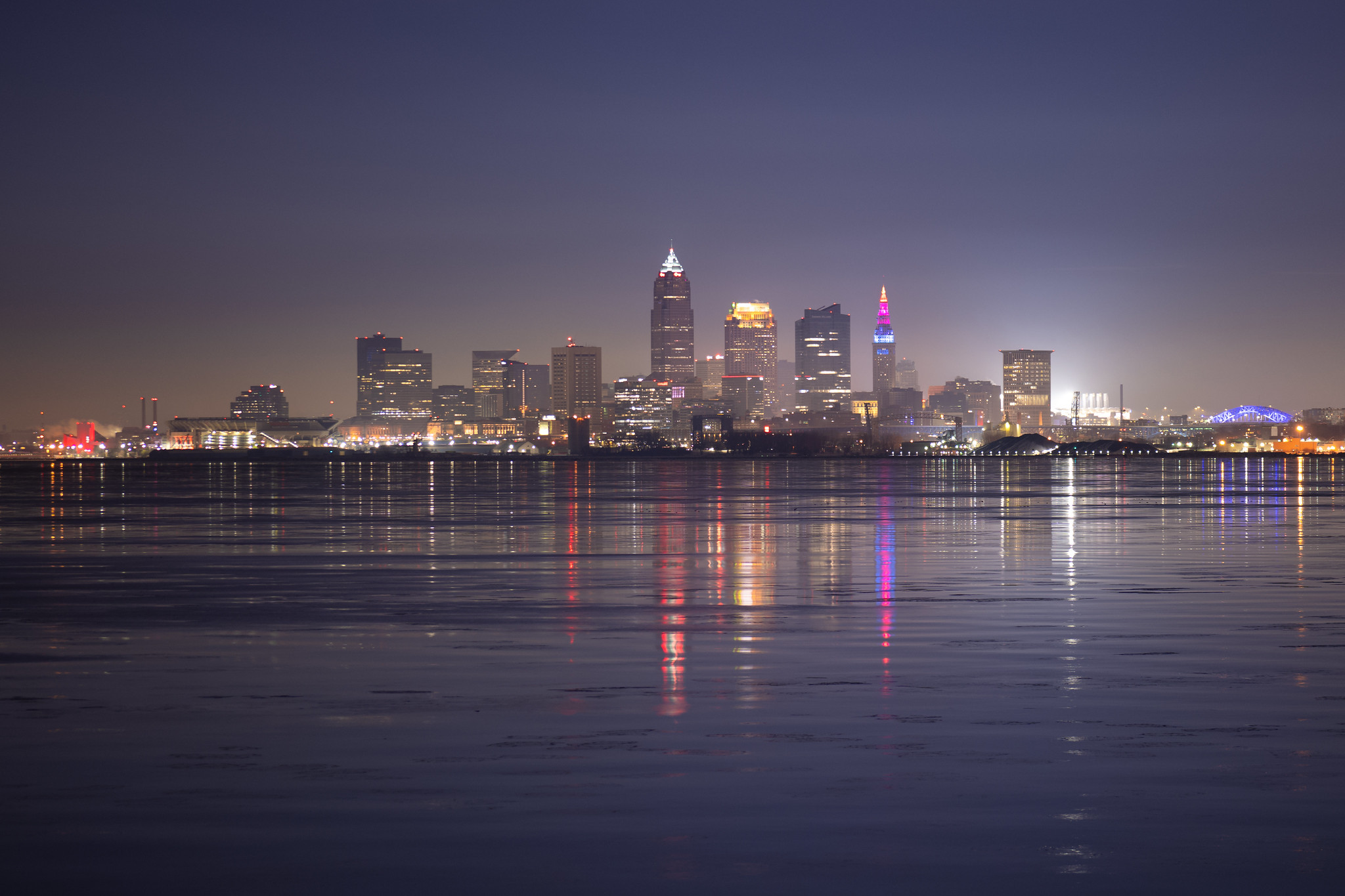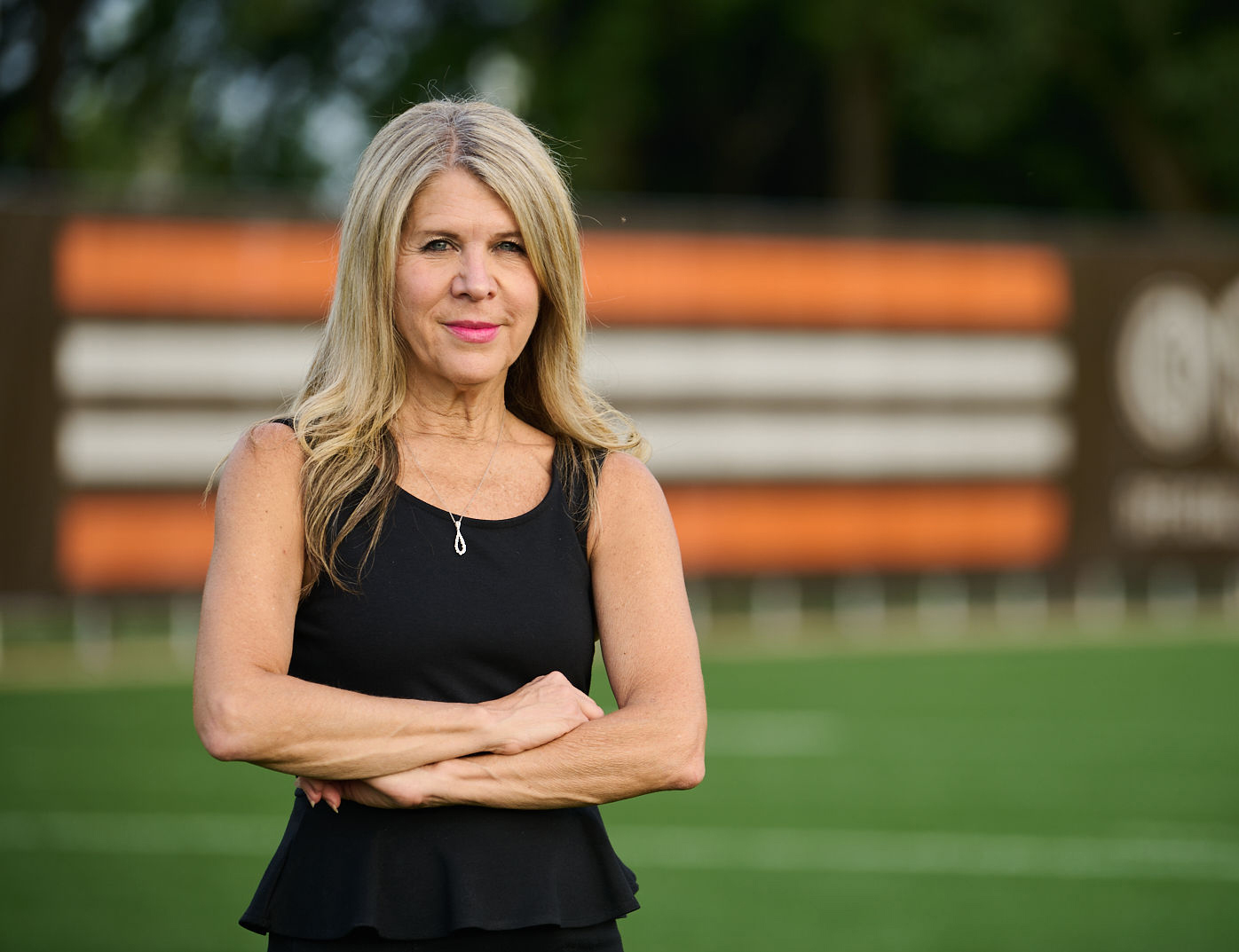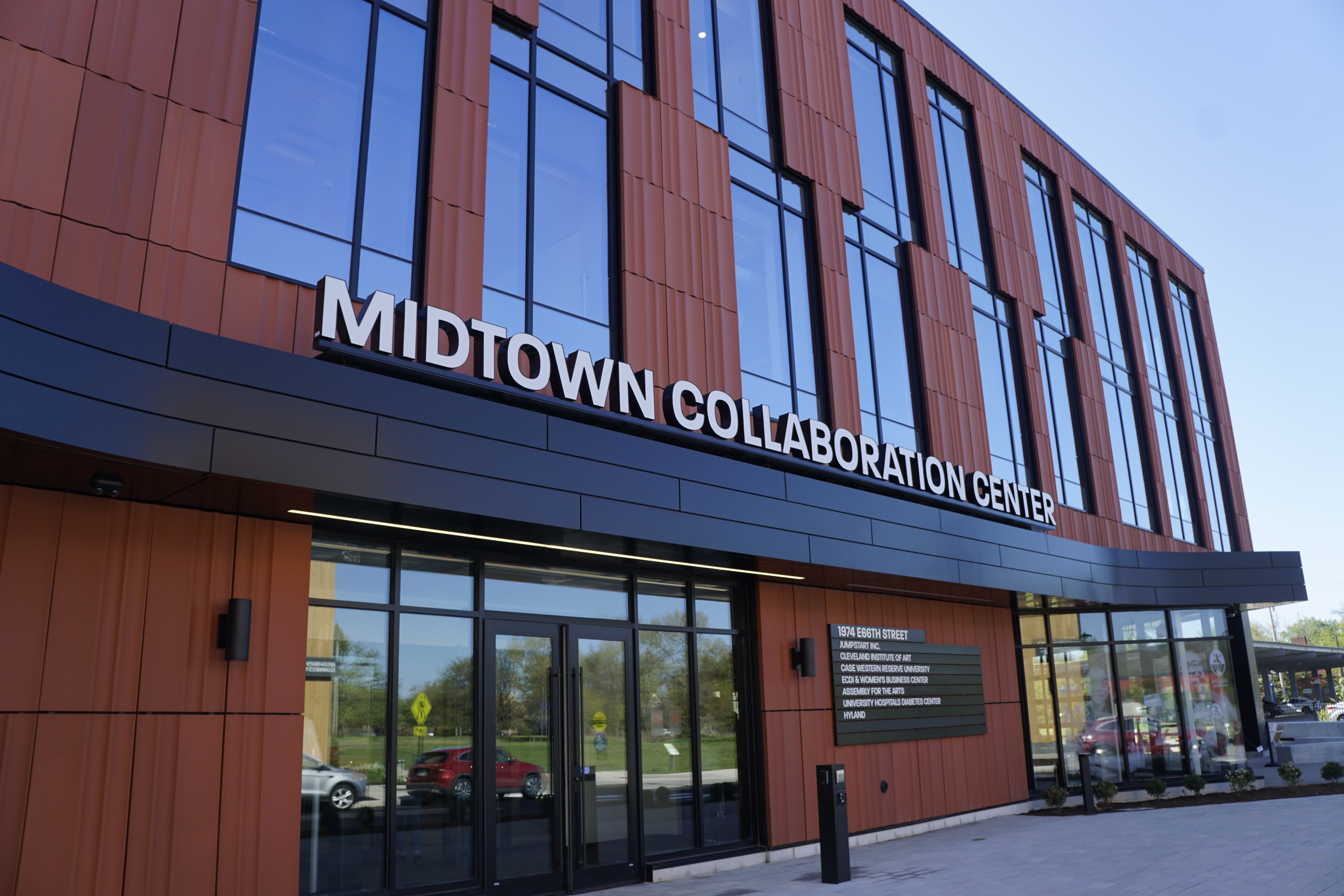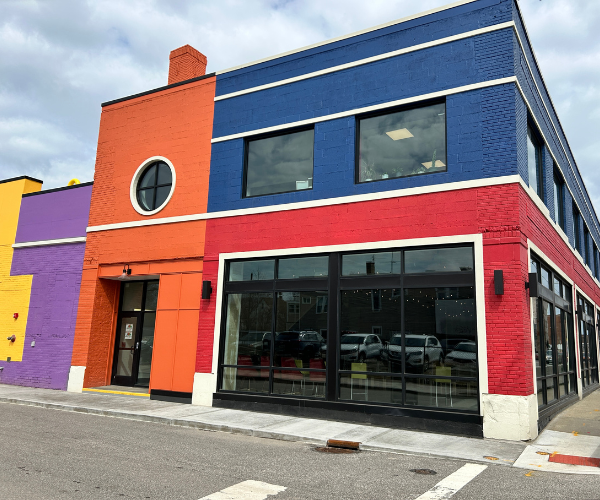Cleveland's Plan to Grow Its Tree Canopy
by Ken Schneck | Jul. 14, 2020 | 12:00 PM

Kendra Huspaska, Ryan Grzybowski, Courtesy Cuyahoga SWCD
Marlane Weslian zips through Slavic Village in her pale blue 2005 Subaru Outback on a rainy morning in March. The pint-size 70-year-old navigates the streets confidently as the neighborhood development officer for the southeast Cleveland community where she’s lived for more than 40 years.
Her eyes dart left and right, never straight ahead. Her focus is not on the road in front of her, but on the yards and empty lots on both sides of the street. Though none of the properties are hers, she still feels a keen sense of ownership, because everywhere you look is a young sapling, one of hundreds of trees Weslian has helped plant over the past four years as a volunteer in Cuyahoga County’s efforts to revive its tree canopy.
“Those three look pretty healthy,” she says of a few thin, 8-foot northern red oak trees planted in a grass-covered lot on Ivy Avenue.
As she keeps driving, pointing out more of her green handiwork, Weslian admits that she hasn’t always had a passion for trees. Though she grew up climbing great oaks and reading books perched in an elm on a Strongsville farm in the 1950s, she is far from an arborist. She can’t name the species of most of the trees she has planted.
“In the beginning, I would call up the landscape guy and say, ‘Just give me trees that will grow big and also trees that will look nice in the summertime,’ ” Weslian explains with a smile. “As I learned more about how quickly the trees were disappearing, I knew I had to learn more.”
Weslian’s learning curve mirrors grassroots efforts all across Cuyahoga County to address the area’s rapidly dwindling tree coverage. According to the Cuyahoga County Urban Tree Canopy Assessment released in December 2019, the county’s tree canopy — the strata of trunks, branches and leaves that cover the ground when seen from above — shrunk from 37% to 35% coverage between 2011 and 2017. Although that mere loss of 2% might not seem like much, it actually represents a stunning collective loss of more than 6,500 acres of trees across the county — equivalent to 5,000 football fields.
For Sandra Albro, director of community partnerships at Holden Forests & Gardens and co-chair of the Cleveland Tree Coalition, an assemblage of more than 30 local public, private and community stakeholders such as the Western Reserve Land Conservancy and Cleveland Neighborhood Progress, that loss of tree canopy equates to much larger issues involving a decline of public health and social and economic disparity.
“The state of alarm has definitely ramped up since the report was released,” says Albro. “Trees provide vital health and environmental benefits, whether it is reducing stress, which relates to heart disease, filtering air, which relates to asthma, or providing more shade, which can reduce the reliance on electric cooling methods.”
Using data from the United States Forest Service, the Cleveland Tree Coalition found the benefits of Cleveland’s tree canopy includes 1,200 less incidences a year of adverse health effects such as hospital visits and respiratory symptoms. According to a 2019 study by the Center for Community Solutions, residents in the Buckeye-Woodhill and University Circle neighborhoods have a life expectancy of 65 years — 23 years shorter than Shaker Heights. Albro points out that Buckeye-Woodhill and University Circle both have 22% tree canopy, while Shaker Heights has 42%.
“Trees are not the cause of it, but they’re definitely correlated to life expectancy,” she says.
Since 2015, the Cleveland Tree Coalition has been working to rebuild Cleveland’s urban forest with a plan that takes stock of the trees that still exist and the neighborhoods at greatest risk of losing their existing tree canopies. By pooling together resources and volunteers, they’re hoping to work with public officials and everyday citizens to create a network dedicated to replanting efforts.
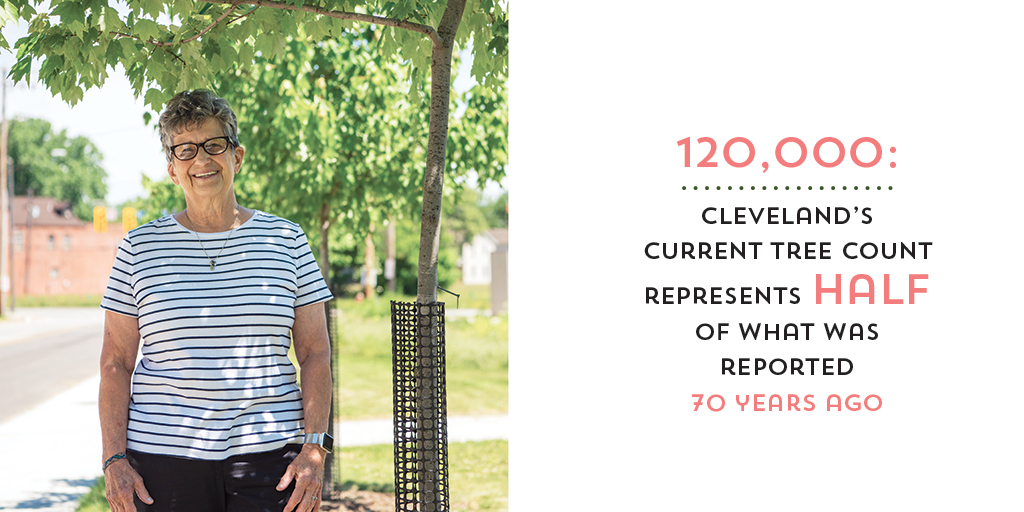
But it’s been no easy feat:
Every year since 2016, they’ve managed to plant roughly 2,500 trees in Cleveland, but in order to ramp up the city’s tree canopy from 19% coverage to 30% coverage by 2040, there needs to be a combined effort to plant 350,000 more trees in the next 10 years. The city then needs to take stewardship of the maintenance and upkeep of all those trees. If we do nothing, the city is on pace to lose 26% of its current tree canopy by 2040. Furthermore, this problem has rippled across Cleveland’s suburbs, affecting a much larger area than originally expected.
“We anticipated what the loss would be for Cleveland, but the rate of loss in the suburbs was surprising given that they generally have more trees to begin with,” notes Albro.
To help with the effort, Cuyahoga County executive Armond Budish has pledged $1 million a year for the next five years alongside Cleveland Mayor Frank Jackson, who’s allocated $1 million a year to the city for the next 10 years, to help with remediation efforts in the chief areas of planning, planting and maintenance. But it will take far more effort than throwing money at the cause and planting new trees — for this plan to grow effectively, the public needs to rally around the problem and Cleveland needs to look to surrounding cities as a learning tool to thrive.
“This is about so much more than planting new trees,” says Albro. “If we don’t take stock of what we currently have and make a detailed plan for how to maintain, planting new trees won’t create the change that Cleveland desperately needs.”
It’s why Weslian is here now as a volunteer, checking up on the growth of her work and taking inventory of the trees her and other volunteers have planted so far. With as much investment as what’s being made by the city and other organizations at large, it will take action from people on the ground like Weslian for this plan to pay off.
“It doesn’t sound as sexy to say, ‘We are cataloguing all the trees in our neighborhood,’ ” admits Weslian. “But we can’t make a difference here unless we have a plan, and we really need to make a difference here before all the trees are gone.”
Cleveland’s roots as a forest city run deep, all the way back to its foundation. When Moses Cleaveland arrived in Northeast Ohio, the area that would eventually become Cleveland had 94% tree canopy coverage. With forested wetlands covering an additional almost 5% of the remaining area, Cleveland’s early days featured an almost totaly tree-covered topography, made up of 26 different tree types, largely beeches and oaks. Even more remarkable, all of these species survived and are still present in the city today.
“There has been no local extinction,” says Kathryn Flinn, associate professor of biology at Baldwin Wallace University. “What’s been lost hasn’t been variety. It’s been quantity.”
Before Cleveland was a bustling industrial mecca, the city looked decidedly more like a frontier in the early 1800s. Public Square was dominated by trees and historical reports indicated that it was a prime location to hunt rabbits and squirrels. The first courthouse was a log cabin and trees dominated the downtown landscape.
Cleveland gained the Forest City moniker in the early 1820s after Leonard Case Sr., president of the Cleveland village council, passed an ordinance requiring shade trees along village streets. As canals were built in the 1820s and railroads roared through the country in the 1840s, that commitment to tree-lined streets began to fade.
“The industrialists changed everything,” says Jon Wlasiuk, former environmental historian at Michigan State University. “The environmental consequences were that forest lands were consumed, with much of it burned by farmers to clear the land quickly.”
When John D. Rockefeller came to Cleveland and built his first refinery in 1863, the city quickly became the national heart of the oil business, with devastating consequences for the local flora. The sulfuric acid released into the air by the proliferation of refineries rained down on Cleveland and destroyed the plant tissue it came into contact with.
“In 1891, Cleveland City Council had to call in forest experts to find out why all the shade trees were dying,” Wlasiuk says. “The experts said, ‘It’s pretty simple. Either stop burning this stuff or plant heartier trees.’ ”
But it wasn’t just the trees that were suffering. With air quality on rapid decline, Clevelanders began experiencing adverse health effects and started dropping in the street due to lack of oxygen.
“They set aside a ward in the city hospital where those people that were suffering from air pollution could go,” says Wlasiuk.
It would be more than 70 years before Cleveland skies cleared up with the closing of coal-based plants, the shipping of refineries overseas and an increase in technologies that filtered out pollutants. But the toll of industrialization, development and suburbanization — along with trees’ old age, an assortment of diseases and violent storms brought on by climate change — all played part in the decline to 19% tree canopy by 2019.
Along the way, the city tried numerous times to lay down roots for replanting
efforts.
Between 1919 and 1924, more than 800 oak trees were planted on what is now Martin Luther King Jr. Drive and North Park Boulevard near University Circle to commemorate those lost in World War I.
The ’80s saw nonprofit Clean-Land Ohio planting trees and gardens on Chester and Carnegie avenues and at the Cleveland-Hopkins International Airport. And in 1996, Trees For Tomorrow planted 10,000 trees to celebrate Cleveland’s bicentennial.
Despite those sporadic efforts, Cleveland’s current tree count of 120,000 trees is only half of what was reported 70 years ago.
“Before the Tree Plan, it was more like symbolic gestures rather than treating trees like infrastructure,” says Albro. “You have to treat it like you would the power grid with regard to having a strong infrastructure. Having golden shovels and planting a tree in the ground doesn’t address the problem.”
In 2015, Cleveland unveiled its first citywide effort to revive its tree canopy with a plan that required an outreach and education strategy, completed a comprehensive tree inventory, and instituted policy changes supportive of urban forestry as a means of getting wide-scale buy-in from the public.
In 2018, the Cleveland Tree Coalition announced its goal of planting 361,000 new trees over a 10-year period to make up for the trees being lost. But volunteers with the Cleveland Tree Coalition have only planted roughly 12,000 total trees to date, far short of the needed change.
“For the first three years of the Tree Plan, we really were trying to do what we could by cobbling together volunteer efforts to push for some change in canopy,” says Albro. “The 2019 [county] report helped establish a sense of urgency.”
The county-wide assessment and Climate Change Action Plan put in place in 2019 revealed that Cleveland wasn’t the only area experiencing great loss in tree canopy. Fifty-nine communities within Cuyahoga County have since been tasked with creating their own tree plans in an effort to collectively increase the county’s coverage to 39% or more to match the national average. Already, 26 entities — cities, community development organizations and nonprofits — collectively received $950,000 from the county to initiate various planning and implementation projects to come up with solutions for increasing the tree canopy across the county.
“We’re not looking to just throw money at projects that would be all planting,” says Mike Foley, director of the Cuyahoga County Department of Sustainability. “This was a way to help get the infrastructure in place for communities without a tree plan in place.”
Some cities, such as Euclid and Cuyahoga Heights, have experienced a 2% increase in tree growth due to already existing tree plans over the last decade. But others, such as Lakewood, which lost 18.5% of its tree coverage from 2011 to 2017, have been rigorously planting trees over the last two years. But those new trees will take another six to 10 years to mature. And while all of Cuyahoga County tries to tackle the problem, Cleveland remains hung up in its earliest stages.
Cleveland City Council put a policy in place in 2018 that required developers to submit tree preservation plans before development projects were approved, requiring any trees removed to be replaced.
“In some suburbs, we’ve seen large developers clear-cut land with no policy to replace those trees,” says Albro. “That’s what we need going forward.”
But even with those policies in place, Cleveland is still spinning its wheels on developing a long-term planting strategy.
Cleveland Magazine’s requests for interviews with several city of Cleveland officials were denied. The city provided a statement outlining two planting periods with more than 300 trees going in the ground this spring and another 1,500-2,000 trees being planted in the fall. The city is preparing to bid out work to complete a tree inventory that will help develop a long-term planting strategy.
But the statement failed to address concrete plans for the maintenance and upkeep of those trees.
“It won’t work to expect that the city is going to fix this problem on its own,” says Albro. “To really make a difference, each community will have to approach this in their culturally specific way, and we are already seeing that happen.”

If you stand at Halburton and Brandon roads in Beachwood, you will see a forest of trees. Even in late April, when the large honeylocusts are not yet in bloom, the stout trunks with their limbs stretching 40 feet to the sky almost obscure the view of the single-family homes on the quiet residential streets.
When the thick green foliage does grow in, it will reach almost across the street, creating an awning of cover for those passing through. You would never know that the intersection is only a few blocks from the bustle of Chagrin Boulevard and only a few more steps to the traffic of Interstate 271. It’s an example of how a thriving, forested suburban neighborhood should look.
“There are only a handful of streets with that cathedral feel to them,” says Chris Vild, Beachwood’s environmental manager. “Our goal is to increase that number.”
According to the 2019 Cuyahoga County urban tree canopy assessment, Beachwood lost a moderate amount of tree canopy from 2011 to 2017, totaling 70 acres. Vild credits the usual suspects for the loss: ongoing development and an influx of emerald ash borers, a beetle that kills young ash trees several years before they fully mature. To stop the spread of infestation, those trees had to be cut down.
“With a high degree of commercial development in the Chagrin Highlands and the removal of our dying ash trees, the 9% loss was anticipated,” says Vild. “We are trying to replace them as quick as we can, but we lost 20-30 years of tree growth removing those trees.”
To address the decline, the City of Beachwood enacted an initiative to replace any trees removed from public property with new ones. But planting the right kind of tree makes a huge difference. Where some of the companies on Eaton Boulevard might want to plant ornamental pears or crabapples, Vild makes the push for more stately alternatives, such as those honeylocust trees on Halburton.
“Bigger species means bigger canopy of trees that sequester more carbon, shade the urban heat island, mitigate stormwater runoff and generally have greater socioeconomic benefits for the community,” says Vild. “Choosing the right kind of trees is what will help increase our canopy coverage.”
Cudell, 13 miles west of Beachwood, experienced a 6% loss. The Cleveland neighborhood of 1.33 square miles is one most in-need of tree canopy, as its loss occurred in a much smaller footprint where residents experience health and social disparities at far higher rates, with 7% diagnosed with chronic heart disease and 12% diagnosed with asthma.
Here, if you stand with your back to Detroit Avenue, to the right of the Cudell Recreation Center, you can almost see an unobstructed view of cars passing by 1,000 feet south on Madison Avenue. A few trees dot the landscape: a three-foot pine tree in the middle of a walkway, various crabapple trees sporadically on the tree lawn and multiple others badly in need of removal from borer infestation. The expansive green area is perfect for more trees in a neighborhood that has potential to plant 344 acres of new canopy.
“Cudell sits snug against Interstate 90, which causes a lot of air quality issues, so trees are really important here,” says Jenny Spencer, managing director of Detroit Shoreway Community Development Organization.
To get the benefits of increased tree canopy and to reach the citywide goal of 30%, Cudell would need to plant 502 trees per year over the next 11 years. Spencer notes that the numbers are aspirational, but doable, provided they have a keen understanding of the nearly 6,500 trees in Cudell’s footprint. By partnering with arborists in the Davey Resource Group, Spencer is taking inventory of existing trees while identifying the kind of trees that will help with noise pollution and removing pollutants from the air.
“We are right now in the middle of conducting a tree inventory, which will help us create a tree plan for Cudell,” says Spencer.
But once cities like Beachwood and neighborhoods like Cudell complete their inventory, the next step is implementing planting and maintaining those new plants over the next 20-plus years.
“At the end of the day, those trees need to be maintained and we’re not going to plant without maintenance,” says Spencer. “We have to manage our expectations for what resources the city will be able to do for maintenance, and we can’t plant trees that would create a burden that the city can’t handle.”
Slavic Village knows what it’s like to wait for the city to do its part, after hiring Bartlett Tree Experts to conduct a five-square-mile inventory of 80% of its tree canopy. The result is a massive, 522-page spiral-bound book that lists the condition of 2,000 trees. Out on the road, those pages become real. Weslian points out the small, one-inch, gold circles screwed directly into the trees, each engraved with a number that corresponds to a line in the spreadsheet cataloging trees subject for removal. Out of 2,000 trees, 111 are slated for removal, with four spray-painted with red X’s to signify they must come down first.
“We passed along to the city all the trees that were deemed high risk. Now, we’ll be looking to the city to take down the trees that are X’ed in red,” says Weslian. “To have done a tree inventory with tree experts that identify which trees need to come down — that’s a first for Slavic Village.”
But Weslian says the city has become complacent when it comes to replacing dead trees, planting new ones on vacant lots and maintaining their upkeep.
“There are trees throughout the neighborhood, especially in the right-of-way, that need pruning and care, which falls to the city,” says Weslian. “It’s not just about the city planting, but also having an aggressive plan to maintain existing trees.”
Still, Weslian trudges on, albeit, against proper protocol. Many of the trees she’s planted are in spaces owned by the city, such as vacant lots and tree lawns. But rather than go through the approval process or wait for the city to plant them, she’s planted trees on her own, without approval, alongside other neighborhood volunteers.
“I know as an outsider, you would say, ‘Geez lady, these streets look like crap,’ but the trees provide beautification and life,” says Weslian. “They make people feel better about some of the way things do look, and that’s a great first step toward transformation.”
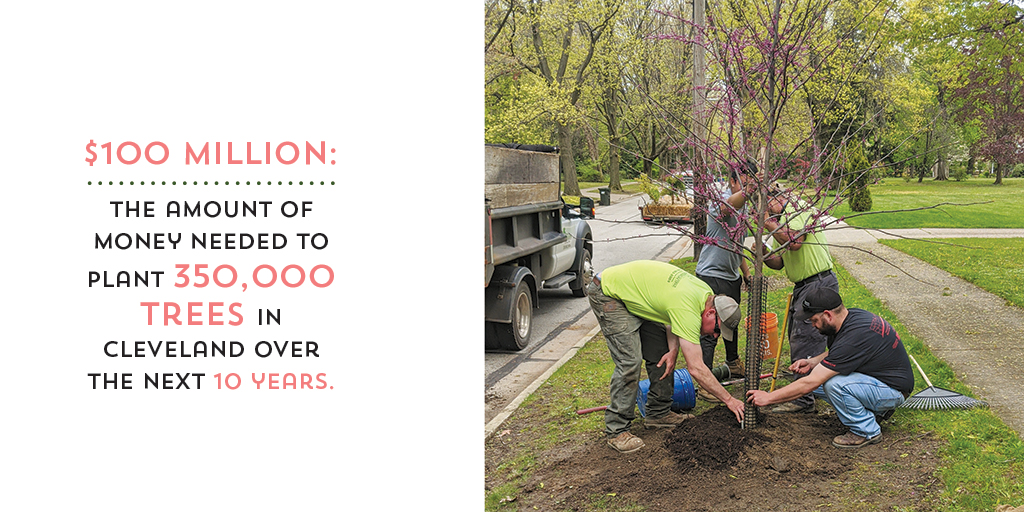
Moving forward, Albro is hopeful but tempered. Although she believes an increase from 19% to 30% tree canopy in Cleveland is achievable, it will require the Cleveland Tree Coalition to raise the sizable investment of $100 million over the next 10 years in order to pull the whole thing off.
“We’re at a tenuous point in the tree plan,” she says. “Right now, we’re trying to prioritize plantings in spaces where capacity exists, where the people who will be maintaining the plans also support trees.”
While establishing a list of potential funders, many of which are already a part of the Cleveland Tree Coalition such as the Western Reserve Land Conservancy, Albro is turning to other successful programs as learning tools to implement at home. She’s in talks with Yale University School of Forestry & Environmental Studies to look at how other cities are privately funding trees. She’s also exploring the use of urban sawmills in Baltimore, used to turn old municipal wood into sustainable products. She also notes that Cleveland Neighborhood Progress has been given a grant to study urban tree nurseries now being used in Pittsburgh.
“The urban sawmills and urban plant nurseries are really getting at private-funding mechanisms and show us ways to create sustainable funding streams for urban forestry,” says Albro.
And while the planning stages continue to unfold, there’s an increased focus on the next phase of maintenance.
“Our worst nightmare is that we spend millions of dollars down the road and all the trees will be dead because the maintenance plan just wasn’t there,” says Foley.
The combined $15 million pledged by the city and county are indicators of commitment, but there’s fear that it might not hold given the vast amount of resources needed.
“By hopefully demonstrating good tree stewardship in neighborhoods that are on board, then hopefully onlookers will get on board,” says Albro. “That’s basic environmental behavioral change. You need a few early adopters to demonstrate how cool it is and that fully changes the culture.”
It takes people like Weslian, who drives around Slavic Village with a trained eye on her saplings, to make this plan work.
She passes by the corner of Portage and Adolpha avenues, where there is a vacant quarter-acre lot of recently upturned dirt, sandwiched between residential homes on either side. A trail of soil leading from the lot into the street indicates the former building here was recently excavated. Weslian slows down and pulls her car up next to the lot.
“I didn’t know this clearing had even happened,” she says.
You can see the wheels turning in her head: measuring the square footage, selecting options from her tree inventory and transforming the bare stretch of land into something distinctly more green. When she finishes her mental calculations, she nods and smiles.
“Check back with me next year and you’re going to see some trees there,” she says.
For more updates about Cleveland, sign up for our Cleveland Magazine Daily newsletter, delivered to your inbox six times a week.
Cleveland Magazine is also available in print, publishing 12 times a year with immersive features, helpful guides and beautiful photography and design.
Trending
-
1
-
2
-
3
-
4
-
5


